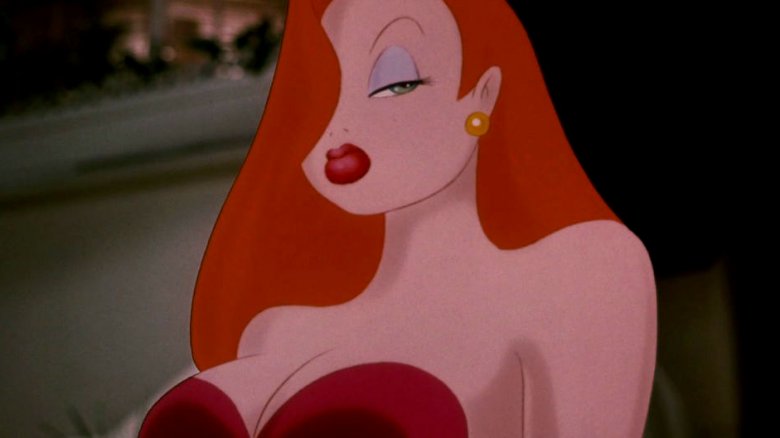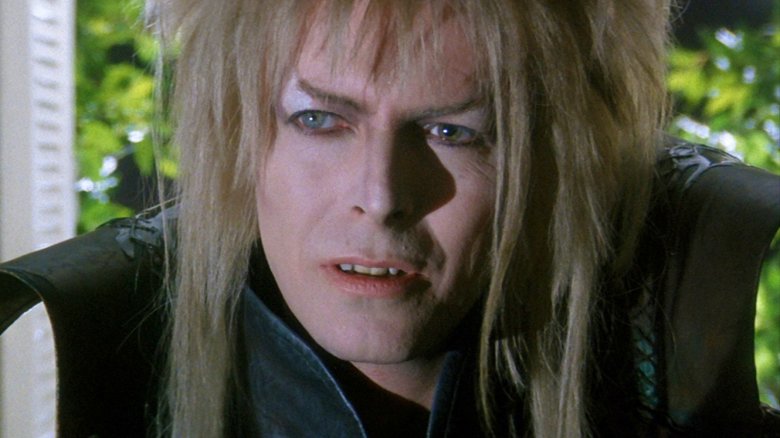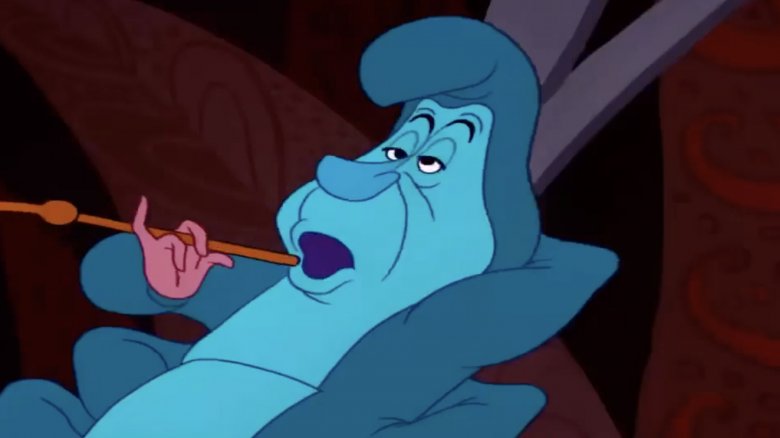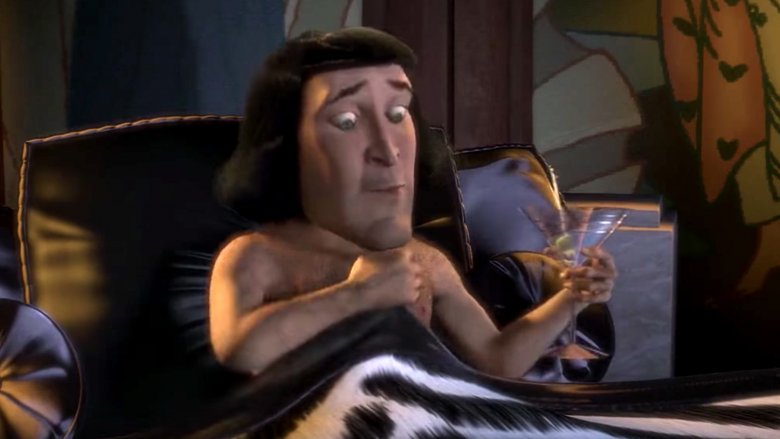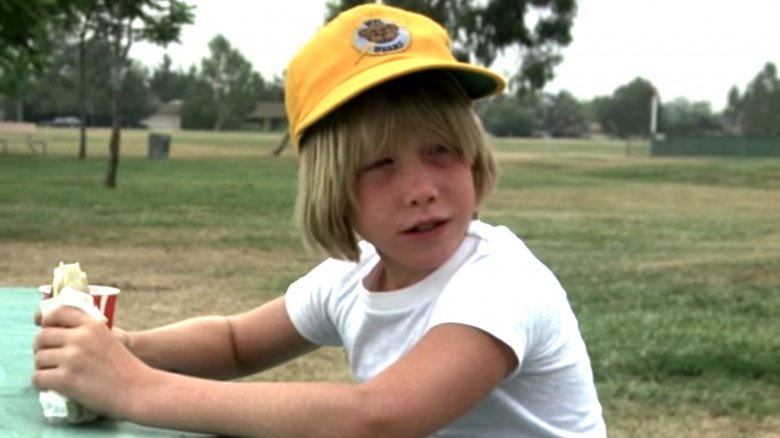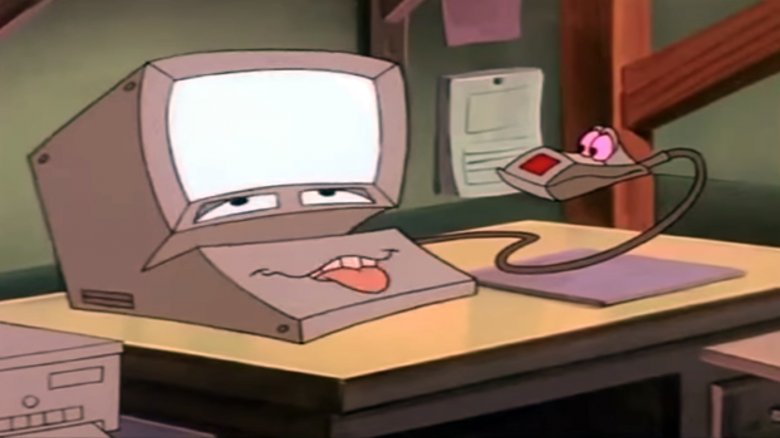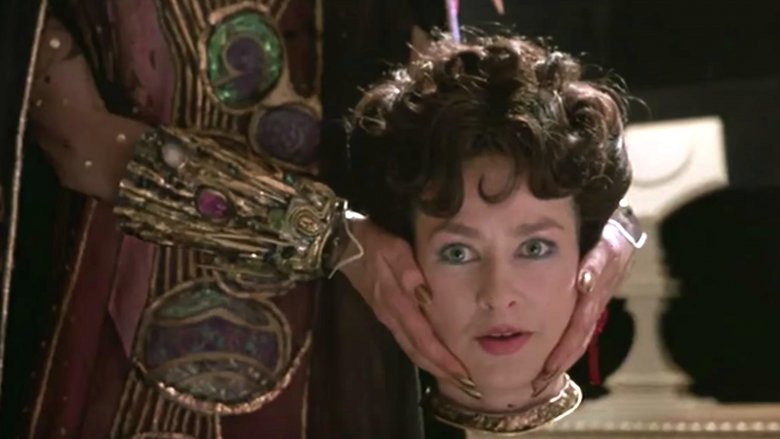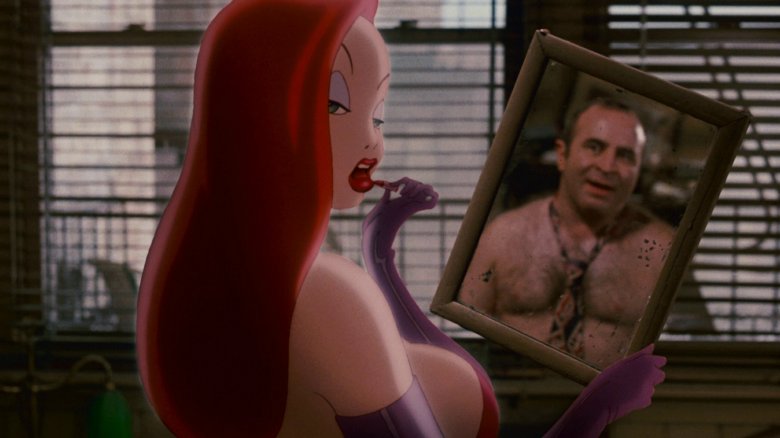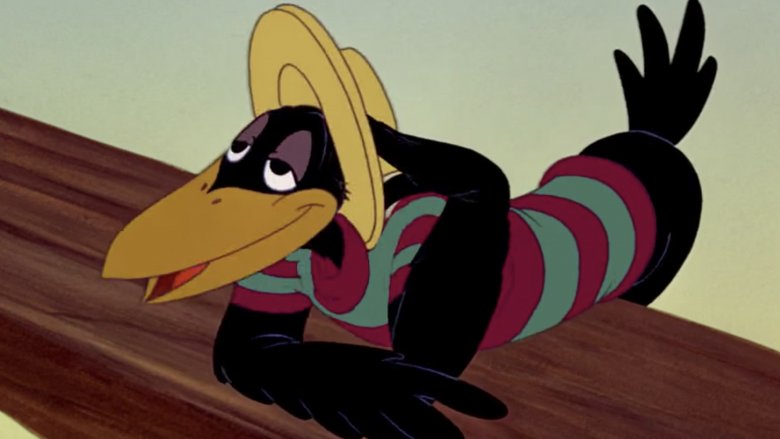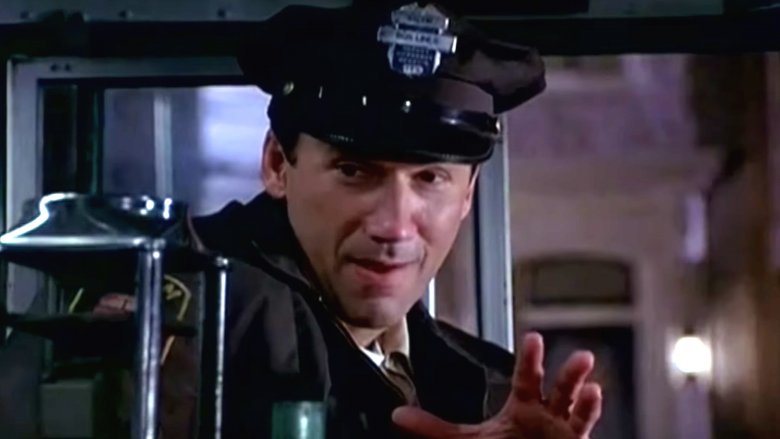Inappropriate Characters That Shouldn't Be In Kids' Movies
Kids already grow up so fast, but sometimes inappropriate characters in family-friendly movies help to expedite the process whether parents like it or not. There's a fine line between harmless characters that appeal to grown-up sensibilities and those that take things a step too far, and Hollywood has a history of straddling that line in a low-cut dress while smoking a cigarette and shouting four-letter words.
Sometimes the characters are overtly sexual in the middle of an otherwise playful movie; other times they're startlingly racist, a little too obsessed with substances, or just plain terrifying in a way that would prompt nightmares in even well-adjusted adults. Kids are people too, and although they deserve to get an accurate glimpse of the real world, sometimes an inappropriate character can show up and add a shocking new dimension to what seemed to be a relatively family-friendly flick. These inappropriate characters definitely shouldn't be in kids' movies.
Jareth the possible sexual predator in Labyrinth
The late David Bowie always brought a preternatural and androgynous sexual charisma to whatever he did. Going all the way back to the days of Ziggy Stardust in the '60s, he had a immense talent for awakening untapped feelings and impulses in impressionable teenagers who were just starting to figure out who they were. It made perfect sense for the Muppets creator Jim Henson to cast him as Jareth the Goblin King in the 1986 dark fantasy Labyrinth — after all, the character basically serves as a gatekeeper between childhood and adulthood, albeit a creepy one with a teased-out Tina Turner haircut.
But Bowie takes the already questionable Jareth to an oddly uncomfortable level of grossness. The character first appears in the bedroom window of 15-year-old Sarah Williams (Jennifer Connelly) and whisks her away to a magical but dangerous realm to find the baby brother he's stolen. While Jareth is meant to be confusing to Sarah, it's pretty clear what he's really after. In a drug-induced dream sequence, Jareth stalks Sarah at a masquerade ball, leering at her in a way that no middle-aged goblin should ever look at a human minor, and eventually proclaims his love for her. Sarah breaks free of his grasp when she realizes he doesn't have any real power over her, and she emerges as a more mature and self-assured version of herself. But Jareth is incredibly lucky that Dateline didn't exist yet.
The Caterpillar and his hookah in Alice in Wonderland
Over the years, there have been plenty of sly drug references in children's cartoons. But the caterpillar in Disney's animated 1951 classic Alice in Wonderland probably takes the cake — and the nachos and the Funyuns. Of course, it's not exactly Disney's fault. The character comes from 19th century author Lewis Carroll, and it's possible that all the drug connections are a modern invention. After all, Jefferson Airplane did a lot to make Alice in Wonderland synonymous with psychedelia. But Disney's version of the caterpillar definitely sparked the thought.
When Alice stumbles upon his darkened lair, he's lazily lounging on a mushroom and singing to himself amid a hazy cloud of smoke. And when Alice needs advice, he tells her that eating one side of a mushroom will make her taller and the other will make her smaller. Sure, he's only smoking tobacco, but that's not exactly a great message to send to kids either. It's not like you'd ever see Tinker Bell step outside for a smoke. At best, that puts the caterpillar in the same category as Joe Camel.
The self-loving Lord Farquaad in Shrek
Lord Farquaad is many things, but subtle is not one of them. In Shrek, the villainous ruler of Duloc (voiced by John Lithgow) is basically a walking sex joke, and other characters repeatedly point it out. First, there's his name. It's pretty clearly meant to sound a lot like a certain swear word, and if your child struggles with "R" sounds, you've probably heard it. Then there's his castle, which is so large (and obviously phallic) that Shrek says Farquaad must be "compensating for something." It's a joke that's repeated in different forms throughout the flick.
But the most blatantly inappropriate moment comes when Farquaad is lying shirtless (but likely naked) in bed with a martini. Looking for something to watch, he tells the Magic Mirror to show him Princess Fiona. The mirror is visibly uncomfortable with his role in the voyeurism, but he makes it happen. When Farquaad sees Fiona, he instantly becomes excited and glances at his crotch beneath the covers — physically. That really happens. Obviously, Shrek is filled with jokes that go over the heads of younger viewers, but this one goes shockingly below the belt.
Tanner and his hate speech in The Bad News Bears
To be fair, you can't really have The Bad News Bears without shortstop Tanner Boyle (Chris Barnes). Although he's not the star of the team or the 1976 comedy, he is the short-tempered, short-statured everykid who represents the rag-tag, rough-and-tumble heart of the Bears. He has some of the best lines and calls things like he sees them, but his foul mouth also spouts some pretty hateful language, even for the '70s.
Tanner is pretty vocal about his disappointment when a girl is added to the roster, and he's not exactly the most tolerant figure in the history of kids' movies. "All we got on this team are a buncha Jews, spics, n*****s, pansies, and a booger-eatin' moron!," he exclaims. While, yes, The Bad News Bears is one of those films that vacillates between family-friendly fare and stuff that's strictly for adults, that didn't stop an entire generation of Little Leaguers from growing up with it. Tanner isn't a role model and he never claimed to be, but he almost single-handedly makes The Bad News Bears an iffy choice for family movie nights.
The orgasmic Computer in The Brave Little Toaster
These days, we're well aware of what computers can do when it comes to opening up a World Wide Web of smut. But in 1987, computers were basically glorified typewriters that allowed you to play The Oregon Trail. Maybe the folks behind the animated flick The Brave Little Toaster were ahead of their time. Based on the 1986 novel by Thomas M. Disch, the movie is set in a world where household appliances and other electronic devices come to life, Toy Story style. However, it's the Tandy-inspired computer (voiced by Randy Bennett) who really learns how to live.
In one scene, a supercomputer prototype named Wittgenstein accesses Computer's data, and it's just slightly less graphic than Meg Ryan's restaurant scene in When Harry Met Sally. Computer is clearly overcome with the kind of pleasure that seems better suited for Showtime than Nickelodeon. "Wow! Wittgenstein is searching through all my files, searching through regions heretofore only dreamed of by man," he says. "Whew ... that feels sorta good. My memory banks are being stroked, and by an expert. I feel something inside of me, and I can't keep it to myself any longer!" If there was ever any doubt that the scene was meant to have some adult themes, the sexy, saxophone-tinged soundtrack hammers it home.
The horrifying Princess Mombi in Return to Oz
It's difficult to pinpoint just one inappropriate character in Return to Oz, the dark and disturbing 1985 sequel to The Wizard of Oz. But one character sits head (and not necessarily shoulders) above the rest. Princess Mombi (Jean Marsh) is actually a character from L. Frank Baum's classic Oz books and the primary antagonist of the second installment, 1904's The Marvelous Land of Oz. She's responsible for removing the Royal Family of Oz and opening the door for the Wicked Witches to conquer and divide the land between them.
But the writers of Return to Oz decided to combine the character with Princess Langwidere, a character from the third book in the series who can wear different heads. That's creepy on paper, but it's absolutely horrifying to see it in a kids' movie. Mombi doesn't just walk around headless some of the time — she also has an extensive collection of heads sort of like what the Faceless Men keep in Braavos on Game of Thrones, but Mombi's heads are still alive and far more terrifying. She also threatens to remove the head of Dorothy (Fairuza Balk), which seems like a grotesque but very real possibility. If the Wicked Witch from The Wizard of Oz gave children nightmares, Mombi sent them directly to therapy. It's probably one of the reasons most people only watched Return to Oz once.
Jessica Rabbit and her two friends in Who Framed Roger Rabbit
Sure, you could probably make a compelling argument that Who Framed Roger Rabbit isn't actually meant for kids. Directed by Robert Zemeckis (Back to the Future) and released four years after the MPAA created the PG-13 rating, it's more of an adult fairy tale. But at the time, the mix of cartoons and live-action footage seemed as groundbreaking as Avatar, and VHS copies were a fixture in homes with children of a certain age. While some of the characters are raunchy (Baby Herman) or downright scary (Judge Doom), it's Roger Rabbit's wife Jessica Rabbit (voiced by the raspy Kathleen Turner) who kickstarted puberty for an entire generation.
An obvious play on the sultry femme fatale archetype in film noir, she infuses a palpable sexuality into the movie from the moment she emerges (legs and breasts first) as a seductive nightclub singer at the Ink and Paint Club. Her ridiculous body proportions are the focus of myriad sight gags, and she can make even the most harmless act (like playing patty cake) seem absolutely filthy. Jessica insists she isn't bad and that she's "just drawn that way," but she doesn't even know the half of it. In one scene, animators seemed to offer a split-second peek at her nethers, but it was removed before the home video release.
The obscenely racist crows in Dumbo
Some characters are wildly inappropriate in kids' movies, and others are just wildly inappropriate altogether. But the crows in Disney's Dumbo are so offensive that they almost belong in their own category. In the '40s, it was pretty common for animators to use racial stereotypes in order to make animals seem more human, and Dumbo arrived more than a decade before the civil rights movement began, so audiences at the time probably weren't all that shocked or disturbed to see a group of crows blatantly based on exaggerated stereotypes of African Americans. The crows sing, dance and smoke like something ripped straight out of racist propaganda from the era.
Although mostly voiced by black actors from the Hall Johnson choir, white actor Cliff Edwards did his most over-the-top "jive" as the lead crow. Even worse: Edwards' character is actually named Jim Crow, referencing racial segregation laws. Some might defend the crows because they're the only characters who help Dumbo during his journey, but it's not like being nice birds cancels out the inherent racism that defines them. Of course, a lot has changed in the world since Dumbo hit theaters, but if you're planning to watch Dumbo with your kids for the first time, you might also want to pencil in a post-movie discussion about bigotry.
The pervy bus driver in Hocus Pocus
We've seen unsavory characters pop up for bit parts in children's movies before, but few are as pushy and inappropriate as the bus driver in 1993's Hocus Pocus. It all goes down when the Sanderson sisters (Bette Midler, Kathy Najimi and Sarah Jessica Parker) try to board a city bus in pursuit of the children of Salem, Mass. Originally from the 1600s and resurrected in the modern era, they have no knowledge of public transportation or, apparently, the ham-fisted pickup lines of the 20th century.
When the driver (Don Yesso) gets a look at the trio, he says, "Bubble, bubble, I'm in trouble," then describes the bus as a machine used to "convey gorgeous creatures such as yourselves to your most forbidden desires." When they specify that they desire children, the driver laughs and says, "Hey, it may take me a couple of tries, but I don't think that would be a problem." After that, he props one of them on his lap (running over a cat while distracted) and badgers her for her phone number. It's not the most egregiously inappropriate moment ever, but it likely ensured that a few parents had to give some version of "the talk" a little earlier than expected.
